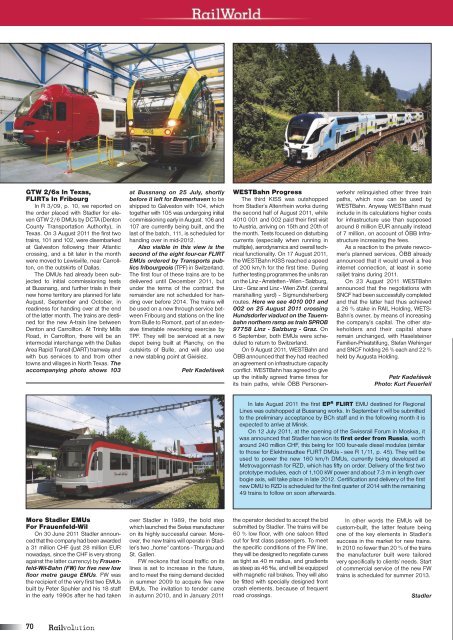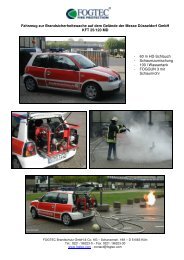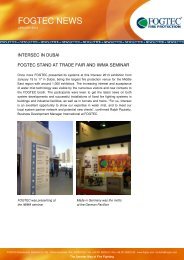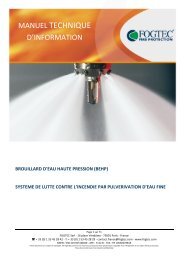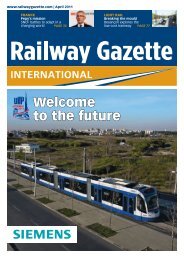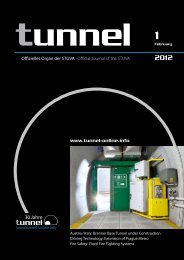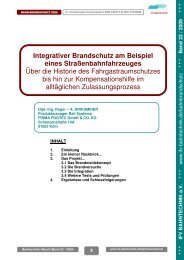Create successful ePaper yourself
Turn your PDF publications into a flip-book with our unique Google optimized e-Paper software.
GTW 2/6s In Texas,<br />
FLIRTs In Fribourg<br />
In R 3/09, p. 10, we reported on<br />
the order placed with Stadler for eleven<br />
GTW 2/6 DMUs by DCTA (Denton<br />
County Transportation Authority), in<br />
Texas. On 3 August 2011 the first two<br />
trains, 101 and 102, were disembarked<br />
at Galveston following their Atlantic<br />
crossing, and a bit later in the month<br />
were moved to Lewisville, near Carrollton,<br />
on the outskirts of Dallas.<br />
The DMUs had already been subjected<br />
to initial commissioning tests<br />
at Bussnang, and further trials in their<br />
new home territory are planned for late<br />
August, September and October, in<br />
readiness for handing over at the end<br />
of the latter month. The trains are destined<br />
for the new A-train line between<br />
Denton and Carrollton. At Trinity Mills<br />
Road, in Carrollton, there will be an<br />
intermodal interchange with the Dallas<br />
Area Rapid Transit (DART) tramway and<br />
with bus services to and from other<br />
towns and villages in North Texas. The<br />
accompanying photo shows 103<br />
at Bussnang on 25 July, shortly<br />
before it left for Bremerhaven to be<br />
shipped to Galveston with 104, which<br />
together with 105 was undergoing initial<br />
commissioning early in August. 106 and<br />
107 are currently being built, and the<br />
last of the batch, 111, is scheduled for<br />
handing over in mid-2012.<br />
Also visible in this view is the<br />
second of the eight four-car FLIRT<br />
<strong>EMU</strong>s ordered by Transports publics<br />
fribourgeois (TPF) in Switzerland.<br />
The first four of these trains are to be<br />
delivered until December 2011, but<br />
under the terms of the contract the<br />
remainder are not scheduled for handing<br />
over before 2014. The trains will<br />
be used on a new through service between<br />
Fribourg and stations on the line<br />
from Bulle to Romont, part of an extensive<br />
timetable reworking exercise by<br />
TPF. They will be serviced at a new<br />
depot being built at Planchy, on the<br />
outskirts of Bulle, and will also use<br />
a new stabling point at Givisiez.<br />
Petr Kadeřávek<br />
WESTBahn Progress<br />
The third KISS was outshopped<br />
from Stadler’s Altenrhein works during<br />
the second half of August 2011, while<br />
4010 001 and 002 paid their first visit<br />
to Austria, arriving on 15th and 20th of<br />
the month. Tests focused on disturbing<br />
currents (especially when running in<br />
multiple), aerodynamics and overall technical<br />
functionality. On 17 August 2011,<br />
the WESTBahn KISS reached a speed<br />
of 200 km/h for the first time. During<br />
further testing programmes the units ran<br />
on the Linz - Amstetten - Wien - Salzburg,<br />
Linz - Graz and Linz - Wien ZVbf. (central<br />
marshalling yard) - Sigmundsherberg<br />
routes. Here we see 4010 001 and<br />
002 on 25 August 2011 crossing<br />
Hundsdorfer viaduct on the Tauernbahn<br />
northern ramp as train SPROB<br />
97758 Linz - Salzburg - Graz. On<br />
6 September, both <strong>EMU</strong>s were scheduled<br />
to return to Switzerland.<br />
On 9 August 2011, WESTBahn and<br />
ÖBB announced that they had reached<br />
an agreement on infrastructure capacity<br />
conflict. WESTBahn has agreed to give<br />
up the initially agreed frame times for<br />
its train paths, while ÖBB Personenverkehr<br />
relinquished other three train<br />
paths, which now can be used by<br />
WESTBahn. Anyway WESTBahn must<br />
include in its calculations higher costs<br />
for infrastructure use than supposed<br />
around 8 million EUR annually instead<br />
of 7 million, on account of ÖBB Infrastructure<br />
increasing the fees.<br />
As a reaction to the private newcomer’s<br />
planned services, ÖBB already<br />
announced that it would unveil a free<br />
internet connection, at least in some<br />
railjet trains during 2011.<br />
On 23 August 2011 WESTBahn<br />
announced that the negotiations with<br />
SNCF had been successfully completed<br />
and that the latter had thus achieved<br />
a 26 % stake in RAIL Holding, WETS-<br />
Bahn’s owner, by means of increasing<br />
the company’s capital. The other stakeholders<br />
and their capital share<br />
remain unchanged, with Haselsteiner<br />
Familien-Privatstifung, Stefan Wehinger<br />
and SNCF holding 26 % each and 22 %<br />
held by Augusta Holding.<br />
Petr Kadeřávek<br />
Photo: Kurt Feuerfeil<br />
In late August 2011 the first EP R FLIRT <strong>EMU</strong> destined for Regional<br />
Lines was outshopped at Bussnang works. In September it will be submitted<br />
to the preliminary acceptance by BCh staff and in the following month it is<br />
expected to arrive at Minsk.<br />
On 12 July 2011, at the opening of the Swissrail Forum in Moskva, it<br />
was announced that Stadler has won its first order from Russia, worth<br />
around 240 million CHF, this being for 100 four-axle diesel modules (similar<br />
to those for Elektriraudtee FLIRT DMUs - see R 1/11, p. 45). They will be<br />
used to power the new 160 km/h DMUs, currently being developed at<br />
Metrovagonmash for RZD, which has fifty on order. Delivery of the first two<br />
prototype modules, each of 1,100 kW power and about 7.3 m in length over<br />
bogie axis, will take place in late 2012. Certification and delivery of the first<br />
new DMU to RZD is scheduled for the first quarter of 2014 with the remaining<br />
49 trains to follow on soon afterwards.<br />
More Stadler <strong>EMU</strong>s<br />
For Frauenfeld-Wil<br />
On 30 June 2011 Stadler announced<br />
that the company had been awarded<br />
a 31 million CHF (just 28 million EUR<br />
nowadays, since the CHF is very strong<br />
against the latter currency) by Frauenfeld-Wil-Bahn<br />
(FW) for five new low<br />
floor metre gauge <strong>EMU</strong>s. FW was<br />
the recipient of the very first two <strong>EMU</strong>s<br />
built by Peter Spuhler and his 18 staff<br />
in the early 1990s after he had taken<br />
over Stadler in 1989, the bold step<br />
which launched the Swiss manufacturer<br />
on its highly successful career. Moreover,<br />
the new trains will operate in Stadler’s<br />
two „home“ cantons - Thurgau and<br />
St. Gallen.<br />
FW reckons that local traffic on its<br />
lines is set to increase in the future,<br />
and to meet the rising demand decided<br />
in summer 2009 to acquire five new<br />
<strong>EMU</strong>s. The invitation to tender came<br />
in autumn 2010, and in January 2011<br />
the operator decided to accept the bid<br />
submitted by Stadler. The trains will be<br />
60 % low floor, with one saloon fitted<br />
out for first class passengers. To meet<br />
the specific conditions of the FW line,<br />
they will be designed to negotiate curves<br />
as tight as 40 m radius, and gradients<br />
as steep as 46 ‰, and will be equipped<br />
with magnetic rail brakes. They will also<br />
be fitted with specially designed front<br />
crash elements, because of frequent<br />
road crossings.<br />
In other words the <strong>EMU</strong>s will be<br />
custom-built, the latter feature being<br />
one of the key elements in Stadler’s<br />
success in the market for new trains.<br />
In 2010 no fewer than 20 % of the trains<br />
the manufacturer built were tailored<br />
very specifically to clients’ needs. Start<br />
of commercial service of the new FW<br />
trains is scheduled for summer 2013.<br />
Stadler<br />
70


